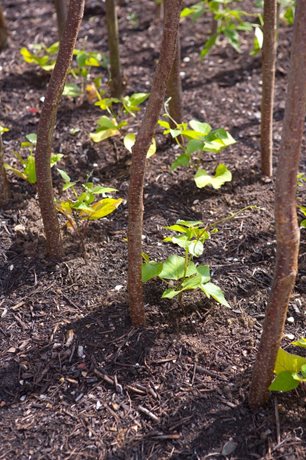Some of our popular crops are sensitive to low temperatures. So how do you get the best out of them in cold weather? Our Chief Horticulturist Guy Barter explains

Believe it or not, summer is fast approaching, and it's time to get going with your tender crops. Nowadays many gardeners focus largely on these ‘warm season’ crops – cucumber family crops such as courgettes, squash, pumpkins and melons, along with French and runner beans, chilli and sweet peppers, tomatoes and sweet potatoes.
Tender crops are vulnerable to chilling below about 12°C. This is because their cell membranes deteriorate with decreased biochemical function below this temperature. This limits their outdoor growing season to mid-May to late September in southern Britain, and often makes them unreliable outdoors in northern areas, where they are best grown in greenhouses.
Keeping warm in cold weather
Greenhouses provide the best conditions for tender crops. However, they are expensive and may not suit people who rent their homes. Polytunnels are fair substitutes, being relatively inexpensive and moderately portable. Unfortunately, they become plastic waste when they are re-clad every five years or so.
Other plastic alternatives are fleece and woven polythene (with one and five year lives respectively). These raise temperatures by about 2°C which can make all the difference in May, June and September, and in cooler regions. However, while they're inexpensive, they're only suitable for low-growing crops and they generate plastic waste. Cloches and cold frames are more costly but produce less waste than fleece or other covers.
 Warm season crops are raised either indoors in pots or cell trays or are sown outdoors from late spring. May is too late to sow small-seeded crops such as aubergines and tomatoes, but plants are still widely available in garden centres. Larger-seeded crops, runner beans and sweetcorn for example, can now be sown direct in the soil as well as indoors.
Warm season crops are raised either indoors in pots or cell trays or are sown outdoors from late spring. May is too late to sow small-seeded crops such as aubergines and tomatoes, but plants are still widely available in garden centres. Larger-seeded crops, runner beans and sweetcorn for example, can now be sown direct in the soil as well as indoors.
Covering soil with fleece or cloches before sowing, and keeping it similarly protected after sowing or transplanting increases your chances of success. Heavy clay soils clay warm up slowly – transplanted crops may be the best option in years like 2021 where spring soils are unusually cool.
Fertile soil in full sun is best for tender crops. Ideally add well-rotted manure or garden compost before planting to increase water-holding capacity, as well as fertility. They tend to be hungry crops, so extra fertiliser either as a top dressing or watered on as a liquid feed in July is often very helpful. Squash and pumpkin tend to produce excessive leaf if over-fed, so go easy with these.
Once tender crops are up and growing all we need is warmth and rain – fingers crossed!
 Pick of the crop
Pick of the crop
Look for the RHS Award of Garden Merit (AGM) when buying vegetable seed or small plants. You can also download the RHS lists of recommended cultivars.
See also

